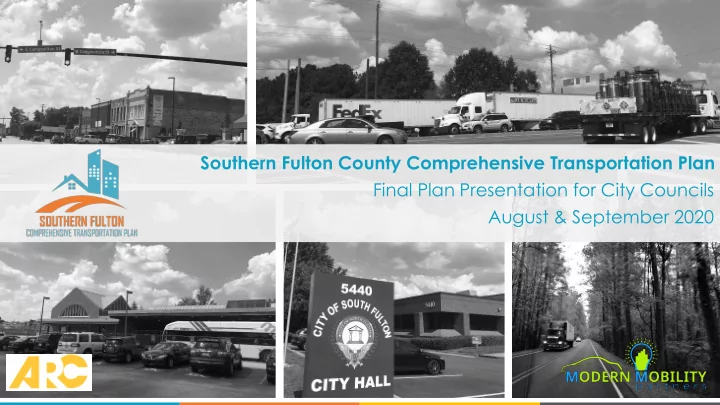

Southern Fulton County Comprehensive Transportation Plan Final Plan Presentation for City Councils August & September 2020
Agenda What is the SFCTP? Study Area, Milestones, and Schedule How Were the Public & Stakeholders Engaged? In-Person and Digital Engagement, COVID-19 Response What are the Recommendations and How Did We Get There? Project Prioritization Results, Recommendations What’s Next? Adoption by City Councils
What is the SFCTP? Study Area, Milestones, and Schedule
What is the SFCTP? ▪ Southern Fulton Comprehensive Transportation Plan (SFCTP) ▪ Master list of prioritized transportation projects for 8 cities across all modes providing mobility options for all users ▪ Financially Feasible Plan ▪ Short-Term (5 years) ▪ Mid-Term (10 years) ▪ Long Term (10+ years) ▪ Can be used to: ▪ Populate project list for next SPLOST program ▪ Apply for federal funding from ARC during project solicitation process
SFCTP Study Area
Plan Overview Milestones & Schedule
How Were the Public & Stakeholders Engaged? In-Person and Digital Engagement, COVID-19 Response
How were stakeholders engaged?
How was the public engaged?
How Were Recommendations Developed and Prioritized? Vision, Goals & Objectives, Needs Assessment, Project Prioritization Framework
What is the Vision?
What are the Goals & Objectives?
How did we account for different users along specific corridors?
How were projects evaluated? ▪ Projects were identified based on the Needs Assessment and stakeholder and public input ▪ The project prioritization evaluation criteria align with the Vision, Goals & Objectives and were developed and refined based on stakeholder and public input ▪ Specific metrics were identified for each evaluation criteria
How does the plan account for differing values among cities when prioritizing projects? • Each city’s prioritization weighting was evaluated based on the online survey in which respondents were asked to select their city. • The average resulted in Safety as the top priority, followed by Connectivity & Reliability and Mobility Options & Access .
How did we prioritize projects?
What Are the Recommended Projects? Final Project Recommendations
How many NEW projects are included in the recommendations?
Recommendations Summary *Note that the numbers of projects by jurisdiction add up to more than the total number of projects because multi-jurisdictional projects are counted in each jurisdiction in which they are located. There are 11 project recommendations that apply to all jurisdictions and are included in each city’s total. The totals also include non -capital project recommendations for plans and studies, which make up 21 of the 381 total project recommendations. Additionally, there are 28 recommendations for coordination and policies, which do not have costs associated with them and are not included in the totals.
Where are the new Short-Term (5-Year) projects in Chattahoochee Hills?
Where are the new Mid-Term (10-Year) projects in Chattahoochee Hills?
Where are the new Long-Term (>10 Years) projects in Chattahoochee Hills?
What are the benefits of implementing these projects?
How was COVID-19, emerging technologies, and other disrupters accounted for? PROJECT RECOMMENDATIONS ✓ Identified smart corridor network ✓ Project cost estimates include fiber (line itemed) for widening and new construction ✓ Installation of communications at traffic signals ✓ Signal preemption for emergency vehicles and signal priority for buses and/or trucks on designated corridors ✓ Flashing beacons for mid-block pedestrian crossings ✓ Bike signals ✓ Electric Vehicle (EV) charging locations ✓ Reduced funding scenario to reflect disruptors that may impact motor fuel tax revenues such as pandemics, connected and autonomous vehicles, and EVs. INVENTORY & NEEDS ✓ Communications equipment (cellular, Dedicated Short-Range Communications (DSRC), and/or fiber) ✓ Smart corridor network GOALS & OBJECTIVES ✓ CVs reflected in Goal #2: Provide a connected and reliable transportation system that operates efficiently supports future growth. ✓ CVs reflected in Objective within Goal #2: Promote innovative approaches for reducing congestion and promoting travel time reliability across multiple modes. VISION ✓ CVs reflected in “connected” transportation infrastructure to support mobility options and economic growth.
What’s Next? Plan Adoption by City Councils
What’s Next? ▪ Presentations are being made to all 8 City Councils (Work Sessions) ▪ Plan to be adopted at next City Council Regular Meeting ▪ Plan adoption considerations: ▪ The final SFCTP must be adopted by at least 5 of the 8 cities in order to be considered an adopted plan by ARC ▪ To apply for federal funding as part of the ARC’s Regional Transportation Plan ( RTP ) and/or Transportation Improvement Program ( TIP ) project solicitation process, projects must be included in the SFCTP adopted plan ▪ If a project arises after the SFCTP is adopted in 2020, the SFCTP can be amended by the Cities to reflect new projects
Where Can I Find More Information? www.southernfultonctp.org
Questions?
Recommend
More recommend